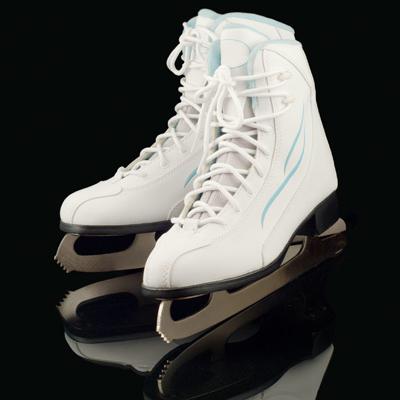
By Renee Allen, MS, ATC, CSCS, ATI athletic trainer for the Conrad Schools of Science in Wilmington, DE
Similar to ballet or gymnastics, figure skating is a unique blend of grace and athleticism. Add an ice floor as the platform, and we’ve got an interesting new set of injury risks. While many skaters go their entire careers without much more than blisters or bruises, more serious injuries can and do occur.
Common Ice Skating Injuries
Whether it’s an overuse or an acute impact injury, ice may seem like the enemy, but it can also be a saving grace when it comes to injury care.
Ice Skating Bruises
Contusions (bruises) are the most common injury in figure skating and can be very minor. However, with repetitive falls or falling “wrong”, what may seem like just a bruise can be or become a stress fracture, especially in the case of the coccyx or tailbone.
Stress Fractures
Stress fractures are also common in the lower extremity such as the feet, shins, or fibula (the thin bone on the outside of the lower leg). These can be from either the stress of the boot and the forces necessary to jump off the ice, or from the repetitive landing impact. Stress fractures often lead to weeks off the ice to allow the bones to heal. They may be difficult to prevent, but making sure the skater is using proper technique can minimize injury.
Wrist Sprains
Wrist sprains can happen from repetitive falling if the skater uses his or her hands to break the fall. Knees are also at risk of being sprained by improper take-offs of twisting jumps, awkward movements or falls -- especially when skating with a partner. While both injuries may require bracing, a knee injury can freeze a skater out for a few weeks until the injury heals. Working on quadriceps and hamstring strength is helpful in the prevention of this injury.
Muscle Sprains
Muscle strains are another very common skating injury. Whether it is a strained muscle in the leg (quadriceps, hamstring, or hip flexors) from jumping and landing, the shoulder (rotator cuff or deltoid) due to lifting a partner, or the back from all of the above, these can be very painful and long-lasting injuries if not properly managed. Rest, evaluation by an orthopedist, and often physical therapy to decrease pain and strengthen the affected musculature are the winning combination to get the skater back on the ice. One way to prevent muscle strains is to warm-up adequately, including doing some stretching (preferably dynamic stretching) before engaging in more intense movements.
Ice Skating Back Pain
Other injuries to the back can also plague figure skaters, like the one that forced Russia’s Evgeni Plushenko to withdraw from the Sochi games shortly before he was to compete in the men’s solo event. Plushenko had a disc in his spine replaced with an artificial one in 2013 and has reportedly undergone approximately 12 surgeries over the course of his career. He was suffering from back pain prior to the event and ultimately decided competition was not worth the risk. Symptoms of disc problems include numbness or tingling and weakness in the legs, which makes skating (especially at a highly competitive level) dangerous.
ICe Skating Concussions
Once in a while a skater will sustain a concussion from a fall. Concussions should be referred to a specialist for best management, especially in the case of young athletes. Younger brains need more care to recover than more mature brains, and a concussion specialist will know exactly what to do.
Physical Therapy for Ice Skating
Many skaters take up the sport at a young age, which makes them prone to Osgood-Schlatter’s Disease during their growing years. This is a condition in which the repetitive stress of landing pulls on the top of the shin bone where the quadriceps tendon attaches, and is most likely to flare up during growth spurts. Since the young skater is still growing, the pull of the muscle on the bone can cause a very painful reaction or even avulsion fracture at the attachment site. This can be managed with physical therapy to strengthen and stretch the leg muscles, bracing to support the knee, and lots of ICE to help with inflammation.
If you’re experiencing pain, Complimentary Injury Screenings are available at an ATI Physical Therapy location near you. Call today to schedule yours!
